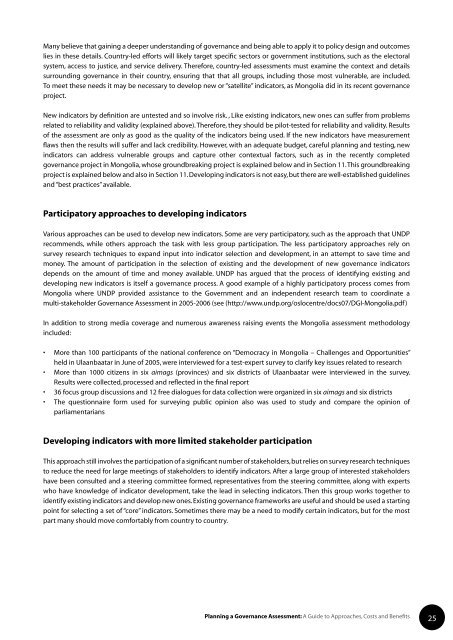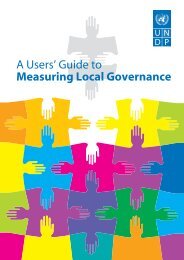planning a governance assessment - United Nations Development ...
planning a governance assessment - United Nations Development ...
planning a governance assessment - United Nations Development ...
Create successful ePaper yourself
Turn your PDF publications into a flip-book with our unique Google optimized e-Paper software.
Many believe that gaining a deeper understanding of <strong>governance</strong> and being able to apply it to policy design and outcomes<br />
lies in these details. Country-led efforts will likely target specific sectors or government institutions, such as the electoral<br />
system, access to justice, and service delivery. Therefore, country-led <strong>assessment</strong>s must examine the context and details<br />
surrounding <strong>governance</strong> in their country, ensuring that that all groups, including those most vulnerable, are included.<br />
To meet these needs it may be necessary to develop new or “satellite” indicators, as Mongolia did in its recent <strong>governance</strong><br />
project.<br />
New indicators by definition are untested and so involve risk. , Like existing indicators, new ones can suffer from problems<br />
related to reliability and validity (explained above). Therefore, they should be pilot-tested for reliability and validity. Results<br />
of the <strong>assessment</strong> are only as good as the quality of the indicators being used. If the new indicators have measurement<br />
flaws then the results will suffer and lack credibility. However, with an adequate budget, careful <strong>planning</strong> and testing, new<br />
indicators can address vulnerable groups and capture other contextual factors, such as in the recently completed<br />
<strong>governance</strong> project in Mongolia, whose groundbreaking project is explained below and in Section 11. This groundbreaking<br />
project is explained below and also in Section 11. Developing indicators is not easy, but there are well-established guidelines<br />
and “best practices” available.<br />
Participatory approaches to developing indicators<br />
Various approaches can be used to develop new indicators. Some are very participatory, such as the approach that UNDP<br />
recommends, while others approach the task with less group participation. The less participatory approaches rely on<br />
survey research techniques to expand input into indicator selection and development, in an attempt to save time and<br />
money. The amount of participation in the selection of existing and the development of new <strong>governance</strong> indicators<br />
depends on the amount of time and money available. UNDP has argued that the process of identifying existing and<br />
developing new indicators is itself a <strong>governance</strong> process. A good example of a highly participatory process comes from<br />
Mongolia where UNDP provided assistance to the Government and an independent research team to coordinate a<br />
multi-stakeholder Governance Assessment in 2005-2006 (see (http://www.undp.org/oslocentre/docs07/DGI-Mongolia.pdf)<br />
In addition to strong media coverage and numerous awareness raising events the Mongolia <strong>assessment</strong> methodology<br />
included:<br />
• More than 100 participants of the national conference on “Democracy in Mongolia – Challenges and Opportunities”<br />
held in Ulaanbaatar in June of 2005, were interviewed for a test-expert survey to clarify key issues related to research<br />
• More than 1000 citizens in six aimags (provinces) and six districts of Ulaanbaatar were interviewed in the survey.<br />
Results were collected, processed and reflected in the final report<br />
• 36 focus group discussions and 12 free dialogues for data collection were organized in six aimags and six districts<br />
• The questionnaire form used for surveying public opinion also was used to study and compare the opinion of<br />
parliamentarians<br />
Developing indicators with more limited stakeholder participation<br />
This approach still involves the participation of a significant number of stakeholders, but relies on survey research techniques<br />
to reduce the need for large meetings of stakeholders to identify indicators. After a large group of interested stakeholders<br />
have been consulted and a steering committee formed, representatives from the steering committee, along with experts<br />
who have knowledge of indicator development, take the lead in selecting indicators. Then this group works together to<br />
identify existing indicators and develop new ones. Existing <strong>governance</strong> frameworks are useful and should be used a starting<br />
point for selecting a set of “core” indicators. Sometimes there may be a need to modify certain indicators, but for the most<br />
part many should move comfortably from country to country.<br />
Planning a Governance Assessment: A Guide to Approaches, Costs and Benefits<br />
25








![GuÃa del Usuario ] - Governance Assessment Portal](https://img.yumpu.com/44740603/1/190x253/gua-a-del-usuario-governance-assessment-portal.jpg?quality=85)







